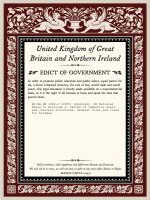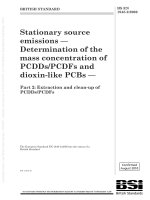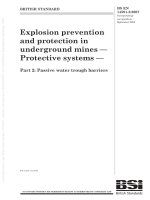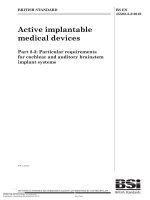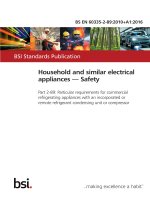Bsi bs en 61300 2 21 2010
Bạn đang xem bản rút gọn của tài liệu. Xem và tải ngay bản đầy đủ của tài liệu tại đây (1.1 MB, 18 trang )
Licensed copy: Bradford University, University of Bradford, Version correct as of 21/03/2012 14:25, (c) The British Standards Institution 2012
BS EN 61300-2-21: 2010
BSI Standards Publication
Fibre optic interconnecting
devices and passive
components — Basic
test and measurement
procedures —
Part 2-21: Tests — Composite
temperature/humidity cyclic test
NO COPYING WITHOUT BSI PERMISSION EXCEPT AS PERMITTED BY COPYRIGHT LAW
raising standards worldwide™
BRITISH STANDARD
BS EN 61300-2-21:2010
Licensed copy: Bradford University, University of Bradford, Version correct as of 21/03/2012 14:25, (c) The British Standards Institution 2012
National foreword
This British Standard is the UK implementation of EN 61300-2-21:2010. It is
identical to IEC 61300-2-21:2009. It supersedes BS EN 61300-2-21:1997
which is withdrawn.
The UK participation in its preparation was entrusted by Technical Committee
GEL/86, Fibre optics, to Subcommittee GEL/86/2, Fibre optic interconnecting
devices and passive components.
A list of organizations represented on this committee can be obtained on
request to its secretary.
This publication does not purport to include all the necessary provisions of a
contract. Users are responsible for its correct application.
© BSI 2010
ISBN 978 0 580 56916 6
ICS 33.180.20
Compliance with a British Standard cannot confer immunity from
legal obligations.
This British Standard was published under the authority of the Standards
Policy and Strategy Committee on 31 March 2010
Amendments issued since publication
Amd. No.
Date
Text affected
BS EN 61300-2-21:2010
EUROPEAN STANDARD
EN 61300-2-21
Licensed copy: Bradford University, University of Bradford, Version correct as of 21/03/2012 14:25, (c) The British Standards Institution 2012
NORME EUROPÉENNE
February 2010
EUROPÄISCHE NORM
ICS 33.180.20
Supersedes EN 61300-2-21:1997
English version
Fibre optic interconnecting devices and passive components Basic test and measurement procedures Part 2-21: Tests Composite temperature/humidity cyclic test
(IEC 61300-2-21:2009)
Dispositifs d'interconnexion et composants
passifs à fibres optiques – Méthodes
fondamentales d’essais et de mesures –
Partie 2-21: Essais – Essai cyclique
composite température/humidité
(CEI 61300-2-21:2009)
Lichtwellenleiter Verbindungselemente und passive
Bauteile Grundlegende Prüf- und Messverfahren Teil 2-21: Prüfungen kombinierte Temperatur/Feuchte, zyklisch
(IEC 61300-2-21:2009)
This European Standard was approved by CENELEC on 2010-02-01. CENELEC members are bound to comply
with the CEN/CENELEC Internal Regulations which stipulate the conditions for giving this European Standard
the status of a national standard without any alteration.
Up-to-date lists and bibliographical references concerning such national standards may be obtained on
application to the Central Secretariat or to any CENELEC member.
This European Standard exists in three official versions (English, French, German). A version in any other
language made by translation under the responsibility of a CENELEC member into its own language and notified
to the Central Secretariat has the same status as the official versions.
CENELEC members are the national electrotechnical committees of Austria, Belgium, Bulgaria, Croatia, Cyprus,
the Czech Republic, Denmark, Estonia, Finland, France, Germany, Greece, Hungary, Iceland, Ireland, Italy,
Latvia, Lithuania, Luxembourg, Malta, the Netherlands, Norway, Poland, Portugal, Romania, Slovakia, Slovenia,
Spain, Sweden, Switzerland and the United Kingdom.
CENELEC
European Committee for Electrotechnical Standardization
Comité Européen de Normalisation Electrotechnique
Europäisches Komitee für Elektrotechnische Normung
Central Secretariat: Avenue Marnix 17, B - 1000 Brussels
© 2010 CENELEC -
All rights of exploitation in any form and by any means reserved worldwide for CENELEC members.
Ref. No. EN 61300-2-21:2010 E
BS EN 61300-2-21:2010
EN 61300-2-21:2010
-2-
Licensed copy: Bradford University, University of Bradford, Version correct as of 21/03/2012 14:25, (c) The British Standards Institution 2012
Foreword
The text of document 86B/2924/FDIS, future edition 2 of IEC 61300-2-21, prepared by SC 86B, Fibre
optic interconnecting devices and passive components, of IEC TC 86, Fibre optics, was submitted to the
IEC-CENELEC parallel vote and was approved by CENELEC as EN 61300-2-21 on 2010-02-01.
This European Standard supersedes EN 61300-2-21:1997.
Attention is drawn to the possibility that some of the elements of this document may be the subject of
patent rights. CEN and CENELEC shall not be held responsible for identifying any or all such patent
rights.
The changes with respect to EN 61300-2-21:1997 are:
– to reconsider the whole parts of the standard;
– to describe the apparatus and procedure in greater details;
– to define with precision the number of 24 cycles in the severity.
The following dates were fixed:
– latest date by which the EN has to be implemented
at national level by publication of an identical
national standard or by endorsement
(dop)
2010-11-01
– latest date by which the national standards conflicting
with the EN have to be withdrawn
(dow)
2011-02-01
Annex ZA has been added by CENELEC.
__________
Endorsement notice
The text of the International Standard IEC 61300-2-21:2009 was approved by CENELEC as a European
Standard without any modification.
In the official version, for Bibliography, the following note has to be added for the standard indicated:
IEC 61300-1
NOTE Harmonized as EN 61300-1.
__________
BS EN 61300-2-21:2010
-3-
EN 61300-2-21:2010
Licensed copy: Bradford University, University of Bradford, Version correct as of 21/03/2012 14:25, (c) The British Standards Institution 2012
Annex ZA
(normative)
Normative references to international publications
with their corresponding European publications
The following referenced documents are indispensable for the application of this document. For dated
references, only the edition cited applies. For undated references, the latest edition of the referenced
document (including any amendments) applies.
NOTE When an international publication has been modified by common modifications, indicated by (mod), the relevant EN/HD
applies.
Publication
Year
Title
EN/HD
Year
IEC 60068-2-38
-
Environmental testing Part 2-38: Tests - Test Z/AD: Composite
temperature/humidity cyclic test
EN 60068-2-38
-
IEC 61300-3-1
-
Fibre optic interconnecting devices and
passive components - Basic test and
measurement procedures Part 3-1: Examinations and measurements Visual examination
EN 61300-3-1
-
IEC 61300-3-4
-
Fibre optic interconnecting devices and
passive components - Basic test and
measurement procedures Part 3-4: Examinations and measurements Attenuation
EN 61300-3-4
-
BS EN 61300-2-21:2010
61300-2-21 © IEC:2009(E)
Licensed copy: Bradford University, University of Bradford, Version correct as of 21/03/2012 14:25, (c) The British Standards Institution 2012
–4–
FIBRE OPTIC INTERCONNECTING
DEVICES AND PASSIVE COMPONENTS –
BASIC TEST AND MEASUREMENT PROCEDURES –
Part 2-21: Tests –
Composite temperature/humidity cyclic test
1
Scope
The purpose of this part of IEC 61300 is to determine the resistance of a fibre optic device to
the deteriorative effects of high temperature, humidity and cold conditions.
It is intended to reveal defects in a device under test (DUT) caused by breathing as opposed to
absorption of moisture. The test covers the effect of the freezing of trapped water in cracks and
fissures as well as condensation. However, the degree of condensation will vary depending on
the size and thermal mass of the DUT.
This test differs from other cyclic damp heat tests in that it derives its increased severity from:
a) a greater number of temperature variations leading to pumping actions in a given time;
b) a greater cyclic temperature range;
c) a higher rate of change of temperature;
d) the inclusion of a number of excursions to sub-zero temperature.
This type of test is particularly important for fibre optic devices made of a variety of different
materials.
2
Normative references
The following referenced documents are indispensable for the application of this document. For
dated references, only the edition cited applies. For undated references, the latest edition of
the referenced document (including any amendments) applies.
IEC 60068-2-38 Environmental
temperature/humidity cyclic test
testing
–
Part 2-38: Tests
– Test Z/AD: Composite
IEC 61300-3-1, Fibre optic interconnecting devices and passive components – Basic test and
measurement procedures – Part 3-1: Examinations and measurements – Visual examination
IEC 61300-3-4, Fibre optic interconnecting devices and passive components – Basic test and
measurement procedures – Part 3-4: Examinations and measurements – Attenuation
3
General description
This procedure is conducted in accordance with IEC 60068-2-38, test Z/AD. The DUT is placed
in a humidity chamber and subjected to 10 temperature-humidity cycles, each of 24 h duration.
During any five of the first nine cycles after exposure to the humidity subcycle, the DUT shall
be subjected to cold.
BS EN 61300-2-21:2010
61300-2-21 © IEC:2009(E)
Licensed copy: Bradford University, University of Bradford, Version correct as of 21/03/2012 14:25, (c) The British Standards Institution 2012
4
4.1
−5−
Apparatus
General
The exposure to moisture, followed by cold, can either be performed in one chamber or in two
separate chambers.
4.2
Chamber for the exposure to moisture
The chamber for the exposure to moisture shall be so constructed that:
a) The temperature can be varied between 25 °C ± 2 °C and 65 °C ± 2 °C in a period of
between 1 h 30 and 2 h 30 for both rising and falling temperatures.
b) The relative humidity can be maintained at 93 % RH ± 3 % RH during the periods of
constant or rising temperature and between 88 % RH ± 8 % RH during the falling
temperature periods.
c) Care shall be taken to ensure that the conditions prevailing at any point in the working
space are uniform and are as similar as possible to those prevailing in the immediate
vicinity of suitably located temperature and humidity sensing devices.
The air in the chamber shall be continuously stirred at a rate necessary to maintain the
specified conditions of temperature and humidity.
d) The DUT shall not be subjected to radiant heat from the chamber conditioning processes.
e) Condensed water is continuously drained from the chamber and not used again until it has
been repurified.
f)
4.3
Precautions shall be taken to ensure that no condensed water from the walls and roof of
the test chamber can fall on the DUT.
Chamber for exposure to cold
The chamber for exposure to cold shall be so constructed that:
a) The temperature can be maintained at –10 °C ± 2 °C.
b) Care shall be taken to ensure that the conditions prevailing at any point in the working
space are uniform and are as similar as possible to those prevailing in the immediate
vicinity of suitably located temperature-sensing devices.
The air in the chamber shall be continuously stirred.
c) Care shall be taken that the thermal capacity of the DUT does not appreciably influence
conditions within the chamber.
4.4
Humidity chamber
The humidity chamber may be used for exposure to cold in which case it shall meet the
requirements of 4.2 and in addition shall be so constructed that:
a) The temperature can be lowered from 25 °C ± 2 °C to –10 °C ± 2 °C in a period of not more
than 30 min.
b) The DUT can be held at a temperature of –10 °C ± 2 °C for a period of 3 h.
c) The temperature can be raised from –10 °C ± 2 °C to 25 °C ± 2 °C in a period of not more
than 90 min.
4.5
Optical source and detector
The optical source and detector used to measure changes in attenuation shall comply with
those specified in IEC 61300-3-4.
BS EN 61300-2-21:2010
–6–
Licensed copy: Bradford University, University of Bradford, Version correct as of 21/03/2012 14:25, (c) The British Standards Institution 2012
5
5.1
61300-2-21 © IEC:2009(E)
Procedure
Preparation of specimens
Prepare the specimen according to the manufacturer’s instructions or as specified in the
relevant specification. The specimen shall be terminated with a sufficient length of fibre cable
to facilitate connection with the optical source and the detector.
Clean the optical and mechanical parts of the DUT according to the manufacturer’s instructions.
5.2
Pre-conditioning (see Figure 1)
Unless otherwise specified, the DUT, switched off, ready for-use-state, shall be subjected to
55 °C ± 2 °C with a relative humidity not exceeding 20 % RH for a period of 24 h prior to the
conditioning.
The DUT shall then be allowed to attain thermal stability at standard atmospheric conditions for
testing or as otherwise specified before the initial measurements are made.
BS EN 61300-2-21:2010
61300-2-21 © IEC:2009(E)
−7−
90
Relative humidity (%)
80
70
60
50
40
30
20
Relative humidity
not more than 20 %
10
0
0
12
24
Time (h)
IEC 2405/09
60
57
53
50
Temperature (°C)
Licensed copy: Bradford University, University of Bradford, Version correct as of 21/03/2012 14:25, (c) The British Standards Institution 2012
100
No specific rate of
cooling is required
40
30
20
Pre-conditioning period
10
Stabilizing period
Drying period
Initial
measurements
0
0
12
24
Time (h)
IEC 2406/09
Figure 1 – Preconditioning
BS EN 61300-2-21:2010
–8–
Licensed copy: Bradford University, University of Bradford, Version correct as of 21/03/2012 14:25, (c) The British Standards Institution 2012
5.3
61300-2-21 © IEC:2009(E)
Initial measurements
The DUT shall be visually inspected and optically measured and mechanically checked as
required by the relevant specification.
5.4
Conditioning
5.4.1
General
The DUT shall be introduced into the humidity chamber, switched off, ready-for-use state, and
mounted in the normal orientation, if this is known, or as otherwise specified and shall be
subjected to 10 temperature/humidity cycles, each of 24 h duration.
During any five of the first nine of the above cycles after exposure to the humidity subcycle (a-f
in Figure 2), the DUT shall be subjected to cold.
This exposure may be performed either in the same chamber or in separate chambers. If
separate chambers are used for the high-temperature/high-humidity and low-temperature subcycles of the test, the DUT should not be subjected to thermal shock conditions unless it is
known that they are insensitive to this degree of thermal shock.
If a batch of DUT is subjected to thermal shock through the use of the two chamber methods
and significant failures occur, a further batch shall be retested with gradual change of
temperatures and shall be considered to have passed the test successfully if no significant
failures occur under these conditions.
The remaining four of the first nine cycles shall be run without exposure to cold (see 5.4.2.1.).
The humidity cycles prescribed are the same in all cases.
5.4.2
5.4.2.1
Description of 24 h cycle
Description of temperature/humidity subcycle (applicable to all cycles, see
Figure 2)
At “zero time” of every 24 h cycle, the chamber condition shall be controlled to a temperature of
25 °C ± 2 °C and relative humidity of 93 % RH ± 3 % RH.
a) The temperature of the chamber shall be steadily raised to 65 °C ± 2 °C over a period of
2 h ± 30 min. During this period, the relative humidity shall be maintained at
93 % RH ± 3 % RH.
b) The temperature and relative humidity in the chamber shall be maintained at 65 °C ± 2 °C
and 93 % RH ± 3 % RH respectively until 5 h 30 after the start of the cycle.
c) The temperature shall then be allowed to fall to 25 °C ± 2 °C over a period of 2 h ± 30 min .
During this period, the relative humidity shall be maintained at 88 % RH ± 8 % RH.
d) Beginning 8 h after the start of the cycle, the temperature shall again be steadily raised to
65 °C ± 2 °C over a period of 2 h ± 30 min. During this period, the relative humidity shall be
maintained at 93 % RH ± 3 % RH.
e) The temperature and relative humidity in the chamber shall be maintained at 65 °C ± 2 °C
and 93 % RH ± 3 % RH respectively until 13 h 30 after the start of the cycle.
f)
The temperature shall then be allowed to fall to 25 °C ± 2 °C over a period of 2 h ± 30 min.
During this period, the relative humidity in the chamber shall be maintained at
88 % RH ± 8 % RH.
g) The chamber shall then continue to run at a stabilised temperature of 25 °C ± 2 °C and
relative humidity of 93 % RH ± 3 % RH until the start of the cold subcycle or until the end of
the 24 h cycle as appropriate.
BS EN 61300-2-21:2010
61300-2-21 © IEC:2009(E)
Licensed copy: Bradford University, University of Bradford, Version correct as of 21/03/2012 14:25, (c) The British Standards Institution 2012
5.4.2.2
−9−
Description of cold subcycle
Applicable to any five of the first nine cycles (see Figure 2).
a) Following the completion of the temperature/humidity subcycle (a-f in Figure 2), the
chamber is maintained at a temperature of 25 °C ± 2 °C and relative humidity of
93 % RH ± 3 % RH for a period of at least one but not more than 2 h.
b) 17 h 30 after the start of the cycle, the DUT shall be exposed to a temperature of
–10 °C ± 2 °C. The ambient temperature of the chamber shall be reduced over a period of
not more than 30 min.
c) Beginning 18 h after the start of the cycle, the temperature shall be maintained at
−10 °C ± 2 °C for a period of 3 h.
No requirement for humidity is prescribed during the entire cold subcycle.
d) Beginning 21 h after the start of the cycle, the temperature shall be raised to 25 °C ± 2 °C.
This temperature shall be reached 22 h 30 after the start of the cycle (see Figure 2).
If the DUT is transferred from one chamber to another, the transfer shall be completed
within a period of 10 min to 15 min.
e) The temperature of the chamber shall be maintained at 25 °C ± 2 °C until the 24 h cycle is
completed.
During this period, the relative humidity shall be 93 % RH ± 3 % RH.
BS EN 61300-2-21:2010
61300-2-21 © IEC:2009(E)
Relative humidity (%)
100
96
93
90
80
70
Relative humidity
uncontrolled
60
10
0
4
2
6
8
10
12
14
16
18
20
22
24
Time (h)
IEC 2407/09
a
b
c
70
d
e
f
*
g
*
60
50
Temperature (°C)
Licensed copy: Bradford University, University of Bradford, Version correct as of 21/03/2012 14:25, (c) The British Standards Institution 2012
– 10 –
40
30
20
1,5
1,5
2,5
1,5
2,5
Preferred limit
1,5
2,5
Permissible limits
2,5
10
Preferred limit
Permissible limits
0
2
4
6
8
10
12
14
16
18
20
22
24
Time (h)
–10
IEC 2408/09
Figure 2 – Exposure humidity followed by exposure to cold
BS EN 61300-2-21:2010
61300-2-21 © IEC:2009(E)
Licensed copy: Bradford University, University of Bradford, Version correct as of 21/03/2012 14:25, (c) The British Standards Institution 2012
5.4.2.3
− 11 −
Description of 24 h cycles with no exposure to cold
Applicable to the remaining four of the first nine cycles.
Cycles which do not include a cold subcycle following the humidity/temperature subcycle are
the same as described in 5.4.2.1, except that in item g) the chamber shall be maintained at a
temperature of 25 °C ± 2 °C and relative humidity of 93 % RH ± 3 % RH until the 24 h cycle is
completed.
5.4.2.4
Description of final cycle
In the final cycle, following the completion of the temperature and humidity subcycle, the
chamber is maintained at a temperature of 25 °C ± 2 °C and relative humidity
93 % RH ± 3 % RH for a period of 3 h 30 after which the final measurements are made.
5.5
Final examinations and measurements
5.5.1
General
On completion of the test, remove all fixtures and make final measurements, as defined by the
relevant specification, to ensure that there is no permanent damage to the DUT. The results of
the final measurement shall be within the limit established in the relevant specification.
Optical and mechanical measurements shall be made:
a) immediately upon removal from the chamber, or
b) after a drying period,
as required by the relevant specification.
After conditioning, unless otherwise specified, visually examine the DUT in accordance with
IEC 61300-3-1.
Check for evidence of any degradation in the DUT. This may include, for example,
–
broken, loose or damaged parts or accessories;
–
breaking or damage to the cable sheath, seals, or strain relief;
–
displaced, bent, or broken parts.
5.5.2
Immediately upon removal from the chamber
On completion of the final cycle, the DUT shall be removed from the chamber and be kept at
standard atmospheric conditions for testing.
If the initial measurements were made under conditions different from standard atmospheric
conditions for testing, the same conditions shall be used for both sets of measurements.
Optical and mechanical measurements, as specified, shall be made within a period of between
1 h and 2 h after removal from the chamber.
Measurements taken early in this time period may be repeated once only, later in the time
period. The later reading will be used for failure determination.
5.5.3
After final drying
On completion of the final cycle, the DUT shall be removed from the chamber and shall be kept
under standard atmospheric conditions for testing for a period of 24 h before the specified final
measurements are made.
BS EN 61300-2-21:2010
– 12 –
61300-2-21 © IEC:2009(E)
Licensed copy: Bradford University, University of Bradford, Version correct as of 21/03/2012 14:25, (c) The British Standards Institution 2012
If the initial measurements were made under conditions other than standard atmospheric
conditions for testing, the same conditions shall be used for both sets of measurements.
Measurements may be made during the 24 h period, but only measurements made at the end
of the 24 h period shall be used for failure determination.
6
Severity
The severity consists of the combination of the relative humidity and duration, the cold
temperature and exposure time, the cycle time and the number of cold cycles.
The number of 24 h cycles shall be 10, unless otherwise specified. If other than 10, the
relevant specification shall define the number and the position of the cold cycles in the
sequence.
7
Details to be specified
The following details, as applicable, shall be specified in the relevant specification:
−
DUT optically functioning or non-functioning
−
DUT mated or unmated
−
Pre-conditioning procedure
−
Recovery procedure
−
Initial examinations and measurements and performance requirements
−
Examinations and measurements during test and performance requirements
−
Final examinations and measurements and performance requirements
−
Deviations from test procedure
−
Severity
−
Additional pass/fail criteria.
BS EN 61300-2-21:2010
61300-2-21 © IEC:2009(E)
− 13 −
Licensed copy: Bradford University, University of Bradford, Version correct as of 21/03/2012 14:25, (c) The British Standards Institution 2012
Bibliography
IEC 61300-1, Fibre optic interconnecting devices and passive components – Basic test and
measurement procedures – Part 1: General and guidance
___________
This page deliberately left blank
Licensed copy: Bradford University, University of Bradford, Version correct as of 21/03/2012 14:25, (c) The British Standards Institution 2012
This page deliberately left blank
Licensed copy: Bradford University, University of Bradford, Version correct as of 21/03/2012 14:25, (c) The British Standards Institution 2012
Licensed copy: Bradford University, University of Bradford, Version correct as of 21/03/2012 14:25, (c) The British Standards Institution 2012
WB9423_BSI_StandardColCov_noK_AW:BSI FRONT COVERS
5/9/08
12:55
Page 2
British Standards Institution (BSI)
BSI is the independent national body responsible for preparing British Standards.
It presents the UK view on standards in Europe and at the international level.
It is incorporated by Royal Charter.
Revisions
Information on standards
British Standards are updated by amendment or revision. Users of British
Standards should make sure that they possess the latest amendments or
editions.
It is the constant aim of BSI to improve the quality of our products and
services. We would be grateful if anyone finding an inaccuracy or
ambiguity while using this British Standard would inform the Secretary of
the technical committee responsible, the identity of which can be found
on the inside front cover.
Tel: +44 (0)20 8996 9000 Fax: +44 (0)20 8996 7400
BSI offers members an individual updating service called PLUS which
ensures that subscribers automatically receive the latest editions of
standards.
BSI provides a wide range of information on national, European and
international standards through its Library.
Various BSI electronic information services are also available which give
details on all its products and services. Contact the Information Centre.
Tel: +44 (0)20 8996 7111
Fax: +44 (0)20 8996 7048 Email:
Subscribing members of BSI are kept up to date with standards
developments and receive substantial discounts on the purchase price
of standards. For details of these and other benefits contact Membership
Administration.
Tel: +44 (0)20 8996 7002 Fax: +44 (0)20 8996 7001
Email:
Information regarding online access to British Standards via British
Standards Online can be found at www.bsigroup.com/BSOL
Further information about BSI is available on the BSI website at
www.bsigroup.com
Buying standards
Orders for all BSI, international and foreign standards publications
should be addressed to BSI Customer Services.
Tel: +44 (0)20 8996 9001 Fax: +44 (0)20 8996 7001
Email:
You may also buy directly using a debit/credit card from the BSI Shop
on the website www.bsigroup.com/shop
In response to orders for international standards, it is BSI policy to
supply the BSI implementation of those that have been published
as British Standards, unless otherwise requested.
Copyright
Copyright subsists in all BSI publications. BSI also holds the copyright, in the UK, of the
publications of the international standardization bodies. Except as permitted under the
Copyright, Designs and Patents Act 1988 no extract may be reproduced, stored in a retrieval
system or transmitted in any form or by any means – electronic, photocopying, recording or
otherwise – without prior written permission from BSI.
This does not preclude the free use, in the course of implementing the standard of necessary
details such as symbols, and size, type or grade designations. If these details are to be used for
any other purpose than implementation then the prior written permission of BSI must be
obtained. Details and advice can be obtained from the Copyright & Licensing Manager.
Tel: +44 (0)20 8996 7070 Email:
BSI Group Headquarters
389 Chiswick High Road London W4 4AL UK
Tel +44 (0)20 8996 9001
Fax +44 (0)20 8996 7001
www.bsigroup.com/standards
raising standards worldwide™

